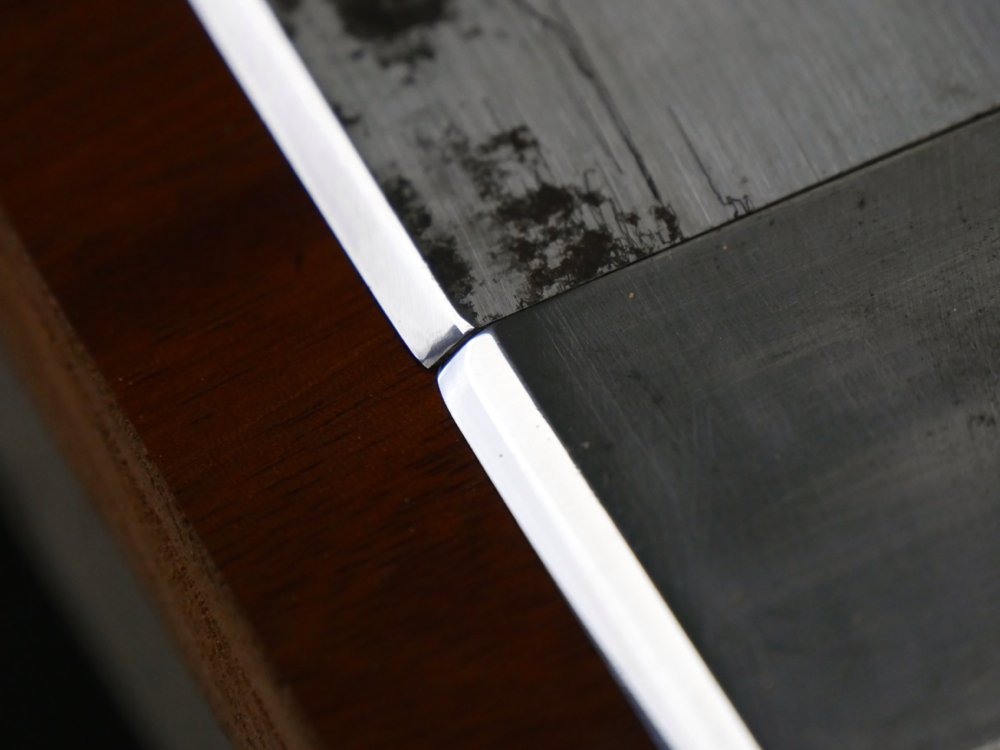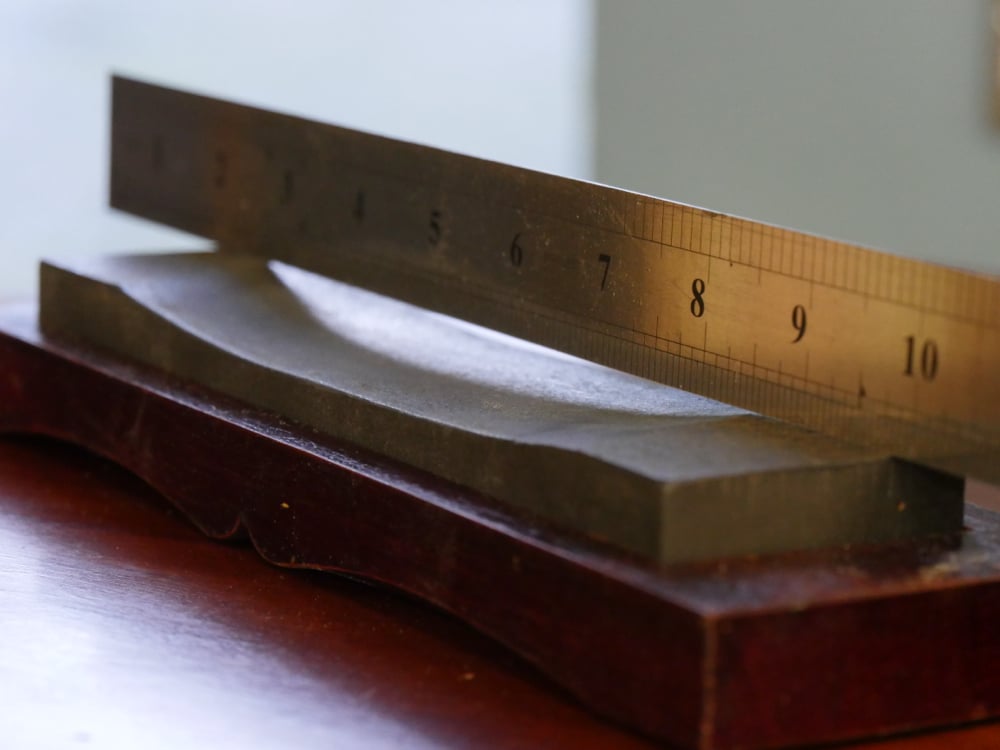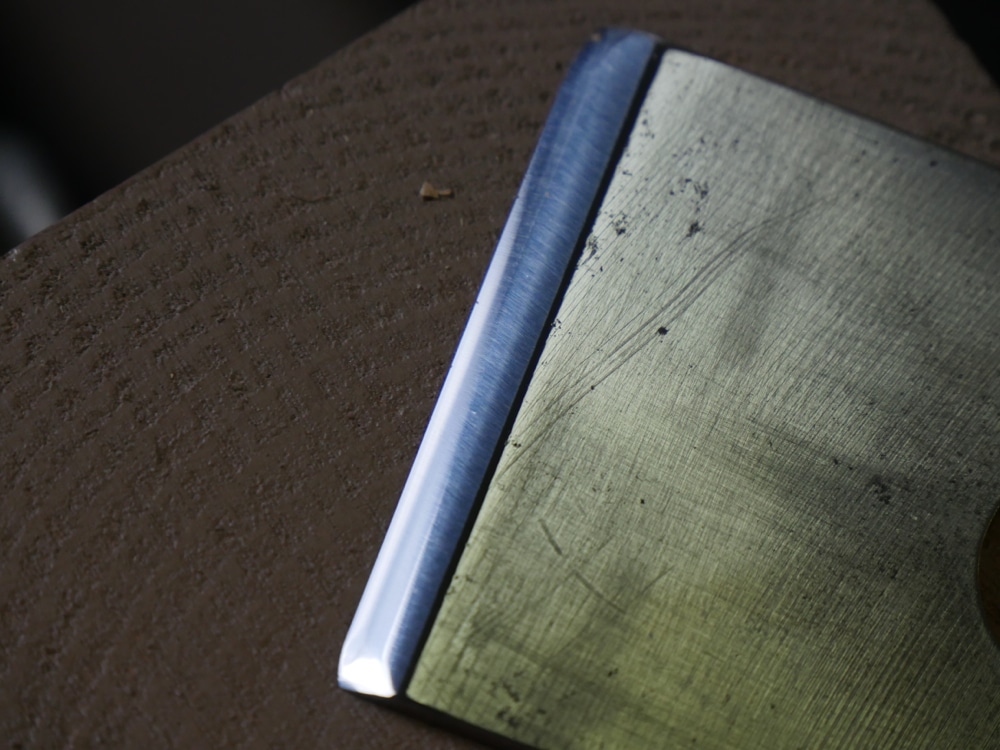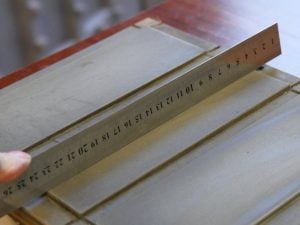Sharpening Wits to Know What YOU Really Need.
In considering my thoughts on sharpening stones I should point out that this does not include sharpening plates because they do retain acceptable flatness tolerances throughout their life and cut steel well too. Sharpening stones of every other type on the other hand have the same inherent problems resulting through varied levels of wear. My experience using them through the decades has given me some insights that might help those who decide not to use diamond sharpening plates for whatever reason and not the least of which is cost.

I suppose first off I might start by asking you the same question I asked myself some years back. Is it necessary to continue applying the large flat face of any tool to abrasive surfaces once the initial flattening, abrading, refining and final polishing is completed? That is, you bought chisels and planes and spokeshaves and put them through this initialisation process, why would you need to abrade what is already polished to perfection? The answer is generally no. In fact, applying the flat face to the abrasive stones only damages the polished work you took the trouble to establish in the first place. That being the case then the stones will be used only for the continued abrading of the bevel alone. If that’s so, it seems to me that the main reason we want straight and flat surfaces is less necessary as we want them more for truing than general sharpening. For general sharpening, to create a cutting edge for woodworking tools, we abrade and polish two faces to an equal level to maximise the sharpness of the edge itself. Both faces are not sharp but polished. On knives, axes and some other tools, the cutting edges are generally formed using two equally sized faces. These tools rely on our polishing out both large surfaces to an equal level and so are generally sharpened from both sides on a continuing basis. For woodworking tools, once the larger flat face is polished, we focus our sharpening on the smaller bevel face alone because abrading and polishing this face gets us to the cutting edge the fastest and easiest and it’s totally unnecessary to repolish the large face because the face retains its refined flatness indefinitely. That being the case, the question must then be asked, why do we need to flatten the stone for so small or narrow a face? Were we to need to abrade and polish the large face every time or even occasionally, then keeping the stone flat makes sense, but that’s not necessary here at all.

Now even on severely curved stone surfaces, where pushing the cutting edge back and forth creates a cambered bevel, the cutting edge will cut perfectly well. If you are persuaded to use micro-bevels, even though this makes no particular sense to me, you can still add a micro-bevel to the edge just as well as you might using a flat stone. The curve to the bevel and the micro-bevel, the camber if you will, will be at the very least as effective as when perfectly flat. There is no discernible difference.
So, that being the case, the only thing that a curved stone surface denies you is using the stone for flattening the large faces, which we have now established you generally have no need of. OK, then that brings me to the next question. What is flat and how do you know if what you are creating is indeed flat? It seems all the more mysterious to me that the only advocates for the need for dead flatness are those selling flattening stones and related equipment. For instance. If your stone is designed and made to abrade, then whatever you use to abrade the abrading stone is surely being compromised by that abrasive and that abrasive process. Doesn’t that then becomes round or bellied? So now we have a sort of push-me-pull-you experience where one thing compromises the other. If we get the fact that we no longer need to have flat bevels and flat stones then we eliminate the problem, but no one as yet has ever been convincing enough to cause me to give up what gives me topnotch surgically-sharp edges freehand in no more than a minute.

Is it obsessional or compulsive activity to spend more time flattening than sharpening and more time doing both than actually working wood? I think first you must establish what it is you are personally looking for. If it’s owning a sharp chisel or plane that’s one thing, if it’s to get fine shavings it’s another and if it’s to get fine cuts on the surfaces you work resulting from the cutting edge then that’s a combinational result of all three. Personally I think that’s what people start out looking for, but then there were often distractions along the way. Where such heightened sharpening activity developed such central prominence from to me seems obvious. 

I am almost done with this I think. One more blog should do it I think.


I can take a machete and sharpen and sharpen and by the time its somewhat sharp it looks like an icepick. Boy can I grind it away. But praise be I’m getting better and better at sharpening chisels, plane irons, even the 151 spokeshave by hand, not great but pretty danged good for me that is. I’ve gotten my hands on some old wooden spokeshaves and even though they have curved profiles I’m hopeful I be able to figure them out eventually. But Mr Sellers I’ve never been hopeful before about sharpening anything and now I am. You are a wizard plain and simple. Thank you for your willingness to teach.
I have been piddling around with woodworking since the late 70’s. I have used waterstones, for me they work, but even to me there seems like there should be a better way.
For the past several months I have been reading your blogs and watching your videos. I felt and still feel the need to be able to sharpen plane irons, chisels and such so I have a benchmark on how sharp one can and should get them.
That said, I was in Restore, a Habitate for Humanity recycle store here in the States, got a 1 x 4 x 24 marble window sill for $5. That and Eliptical Honing fixture, various grits of wet-dry sandpaper and cheapo window cleaner. By golly I can sharpen plane irons.
Give me a few weeks getting use to using the wheelchair, I’ll move onto crutches and then “Free at last. Free at last.” do it freehand.
Thanks Paul
I have to say thanks again for you excellent YouTube sharpening videos. I’ve said before, the burden of ignorance was lifted from my shoulders. I went whole hog and got the diamond stones but I’ve gotten equally good results with the very cheap double sided stone that I use for my spokeshaves. It’s good to see this series, pointing out that there’s no magic in the diamond plates themselves. Some advertising wants to sell sharpening systems with the same approach as they use to sell golf clubs; that you just need exotic materials or elaborate training mechanisms to achieve a proper edge.
….actually, I should append this to say that the coarse diamond plate is magic. Much easier than trying to get a square, straight hollow grind on a wheel.
Thanks for this. I saw a video today that told me my edge tools were useless unless I was using a $130.00 16,000 grit ceramic stone. It was also mentioned by the author that as an American, that’s not expensive for me and I probably spend that much weekly on coffee.
Salesmen and corporate shills should not be content creators
You can get a ~16,000 grit finish without great expense or fancy stones. Just make a simple strop: leather glued to wood or just use smooth wood/MDF without leather. Optionally coat the strop with some green or white compound (get a big “lifetime” block for ~£5) or Autosol metal polish (or a cheap generic equivalent, e.g. from Aldi).
I have built up a small collection of sharpening wheels, stones & plates. I rarely use the 8000 grit waterstone – but I almost always use my strops. I make my strops with handles, as I usually prefer to take the strop to the blade, rather than vice versa.
The face of an iron doesn’t stay polished indefinitely. There is the normal wear and tear from using the tool which works on both sides. There is the burr from sharpening the bevel. There is oxydation, there are the usual and unusual scratches from daily workshop practice. And how about when you acquire a nice old vintage chisel, won’t you need a sequence of reasonably flat stones to repair its back side?
Also, people who use a different sharpening regime don’t “spend more time sharpening then woodworking”. Using waterstones can be very quick too. And flattening them with a diamond stone doesn’t take much time either.
I don’t think your arguments are very convincing. But I am also curious how the old craftsman managed with hollowed stones. So I hope your next blog is better.
Other then that I enjoy your blogs a lot. Keep up the good work.
As to how they got along with hollowed stones, you’ll just need to watch the youtube video on how he sharpens chisels and then try it. I bought a few old oilstones, oiled them up, put ’em in boxes and sharpened away after watching it, and I get glass surfaces left by my cutters.
Waterstones do indeed work and I don’t think I’ve ever heard anyone say that they didn’t. But with a piece of glass as a flat surface (I broke mine this past week… I should’ve bought tempered, or I should have made the box to put it in to protect it, but I digress) flattening isn’t something you can’t do. I think what he’s getting at is that it doesn’t have to be done every time you hone up your edge and nowhere near as obsessively as the guys selling bazillion-grit electric magic wheels keep trying to convince us.
The very first time the edge sees wood the burr is coming off; oxidation is only an issue if someone does not take care of the tools (oil them a little, and don’t dunk them in salt water); and minor scratches aren’t anything to worry about and won’t affect the edge one bit, but major stuff, like dropping on concrete, definitely counts.. been there, done that. He’s not saying don’t polish the back (see the video!). He’s saying don’t drive yourself into a tizzy over it.
The hollowed stone still works well for the edge. It simply won’t flatten. I haven’t seen anything that would indicate that the ‘woodworkers of old’ (sic) didn’t also happen to keep a flatter stone in a drawer specifically for that purpose. At least I would have, if I were in the habit of buying a lot of old tools…but they were new then, and needed it less.
Oxidation and tarnish of that lightness doesn’t affect the sharpenability at all, Kees. Even scratches are not as you say and neither is wear because the cap iron covers almost all of the surface apart from a millimetre or so. Its actually the edge itself that wears down, the sharp edge formed by the intersecting flat faces, and not the face as such.
In saying some people spend more time sharpening than woodworking I’m saying that’s what they like doing and therefore there is nothing wrong with that.
It’s long been researched that the face does wear away quite a bit further then the edge. The best illustration is here: http://bladetest.infillplane.com/html/wear_profiles.html. There are many other real scientists who have researched similar wear profiles.
The question is of course, how bad is this face side wear bevel in a bevel doen plane? I think it is quite polished allready, but it certainly isn’t flat.And those little scratches, even from just positioning the capiron, are going to end up in your edge sooner or later, and won’t enhance it.
We really shouldn’t forget the burr. I think that is the most important part. Ripping it off in the wood isn’t going to produce a very fine edge. Going back and forth and abradding it on a fine stone and/or with a strop works much neater.
I used to use waterstones (and I was quick with these!) and recently switched to oilstones because I didn’t like the mess anymore. I am definitly not in the ultra expensive doodad camp, being quite a cheap skate. But the arguments in this blog didn;t strike me as very convincing.
Its all relative.
you will likely remove at least 1/50th of a mm of material from the end plane iron or chisel when you sharpen it on stone/plates. In which case you would be through the rounded back edge to the flat surface. You arn’t going to remve the rounded edge from the back unless you reduce the thickness of the blade or you create another bevel on the the back. working form the bevel will be more efficient.I may be wrong but when Paul is saying micro scratches on the back not effect an edge he isnt saying that if you are going for the ultimate edge they will not effect it, but that in a practical user sense they do not have a noticable effect on the real world use of the tools.
lol I just read to the bottom of that article you posted i’ll quote it
“Producing a new sharp edge CAN BE DONE BY REMOVING STEEL FROM THE BEVEL ONLY” the article backs up Pauls assertion about being able to sharpen the bevel side
I would imagine craftsman took pride in the fact their stones were well worn and dished out. It probably was living proof on how hard they worked.
My main tools are Japanese white carbon edges and waterstones, several natural stones and some man made. When I started using natural stones, I took a good look and realized that according to a flat earth policy I’d have to remove a considerable percentage of available surface to flatten them; so being quite cheap with these very expensive natural stones, I started looking for a large enough flat (mostly) area for the tool in question and sharpening within the confines of that flat surface, gradually increasing the area covered via sharpening tools alone, without flattening. It works., amazingly enough. I do have to have another stone or two that I’ve flattened to work the backs, but I don’t need to do too much of this.
Pam
Thanks Pam, down to earth flatness has a place but we are organically shaped human beings. I kinda like that we are not yet pugmilled to become what we are.
Thanks for spreading your knowledge Paul. I really learn a lot of “new” (really should be old) knowledge that simply is not available elsewhere about hand tool work.
This series about sharpening really opened up my eyes to some things I have observed in the old tools that I love to restore and use in my workshop. Most of the tools I have restored had the type of edge you are talking about, and as a fool I have ground this off at a considerable time-penalty as the authorities on sharpening say that it should be flat.
Now thinking of what you are saying it is so obvious that we as a society have become so accustomed to the results that come from machines, that this has become the standard that everything should be measured against, even though the results are merely there because it is easier to make straight, flat surfaces in a machine than it is rounded, more organic surfaces.
I know from my father that he always used the old ways taught by you, that was what I was accustomed to and preferred in terms of looks as it looked more natural, but the “authorities” made me change my ways *sighs*..
Well, again thanks for spreading the word, I’ll start to sharpen in “ye olden way” again 🙂
Larry Williams (of Clark & Williams-(www.planemaker.com) says: Y use three stones in sharpening: a medium India, a Translucent Hard Arkansas and a coarse diamond stone that’s only used to maintain the other two. The two oilstones, contrary to what people say, do wear but they also get dull. Very brief use of the coarse diamond stone on both oilstones before each sharpening keeps the oilstones flat and fast cutting. Everyone talks about flat in sharpening but no one ever says why. What we look for in flat is repeatability. If the stone are uniformly flat, you don’t have to make a tool conform to a different topography each time you change grits. I used to waste most of my honing time making a tools conform to the out-of-flat shape of my stones. I don’t do that anymore: when I switch between stones, they cut in the same locations. First dress the fine hard Arkansas then the coarser India stone. Leave the resulting slurry on the stones: it makes them cut faster. I also use a leather strop to remove the final wire edge.
I don’t have to be a Buddhist to believe in Karma. I myself are not an oil stoner and I don’t know how much stock Larry has invested on a coarse diamond stone. They actually make molding wooden planes and are not taking orders there so back up. In practice you’ve opted for the plates and the strop. After all the discussion on abrasives and the contour of sharpening stones we have not even talk about diamond paste, talk about a shape, a paste really? The options are there for any one to indulge. There are many paths to the top of the mountain each must choose its own. What I got from this discussion is not to follow blindly every path that’s presented. To those that do not have the resources to spend on a certain system the options are more limited and If the hollow stone is the way to go then it is what it was.
Hey Paul, thanks again for another in-depth foray into the methods of woodwork. Awhile ago, based on your videos and posts, I began to sharpen my blades using this method which creates a rounded bevel on the edges of my tools. I have had better luck getting sharp edges this way and I can say that I truly prefer this method because of its no-fuss effectiveness. There is only one thing I have noticed and would like to ask about: Do you find that you lose stability when using chisels bevel-down (especially the wide ones)? My chisels tend to want to rock a bit on the bevel (since it is rounded) and I am wondering if I am doing something wrong.
Thanks again for all your wonderful content. You really are contributing to the life and longevity of the trade.
I am a beginner woodworker and i read your books and blog and watch all your videos . You have been a great teacher for me. I bought a honing guide to sharpen my plane irons and chisels but i only used them twice. You make sharpening look so easy and it made me want to learn how to, so i have been sharpening free handed for a while and i am getting pretty good now. It is alot faster than using a honing guide after i have figured out how to do it. Thank you for being such a great teacher and woodworker.
Holly
I have watched your videos and you are great 1
35 years of sharpening chisels were all wrong with a belt sander !
I looked and learned from you and made wood gigs out of oak and cheery and for different degrees of chisels and hand planes accurate and simple !
If you want pictures to make a better version you are more than welcome !